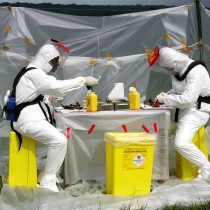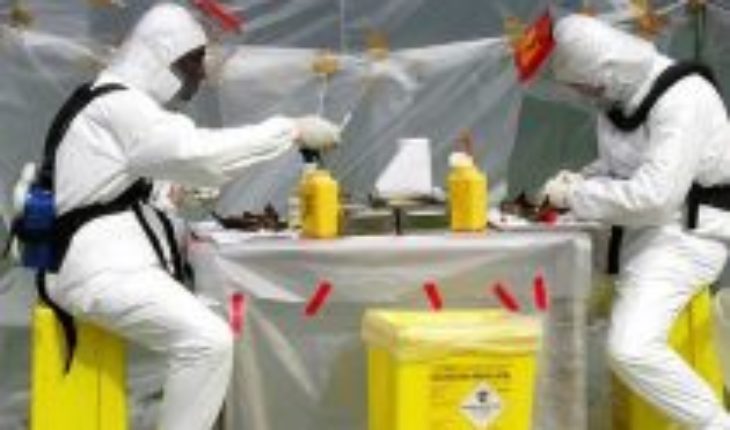
The current COVID-19 coronavirus epidemic, which began in Wuhan late last year, is a good example of the threat posed by emerging infectious diseases, not just human and animal health, if not also for social stability, trade and the world economy.
But there is enough evidence to believe that the frequency with which new infectious agents appear could increase in the coming decades, raising fears of an imminent global epidemiological crisis. Indeed, human activities cause profound changes in land use as well as significant alterations of biodiversity in many parts of the planet.
These disturbances occur in an international connection environment exacerbated by human displacement and trade, all in addition to climate change.
These are the optimal conditions to favor the passage to humans of pathogenic microorganisms from animals. However, according to WHO, the diseases caused by these transmissions are among the most dangerous.
Identifying new threats
Crimean-Congo haemorrhagic fever, Ebola virus and Marburg virus disease, Lassa fever, Middle East Respiratory Syndrome coronavirus (MERS-CoV) and severe acute respiratory syndrome (SRAG), Nipah virus and diseases associated with henipavirus, Rift Valley fever, Zika virus…
All these diseases share the fact that they are included in the “list of priority diseases”, established by WHO in 2018.
The diseases listed here are considered as priorities for research to focus on. Given their epidemic potential and the absence or limited treatment and control measures currently available, they undoubtedly pose a large-scale public health risk.
This list also includes an “X-disease”. This enigmatic name indicates the disease that will be responsible for a major international epidemic, caused by a pathogen still unknown. WHO has no doubt that it could happen, so it calls on the international community to prepare itself in anticipation of this catastrophic scenario.
At present, public health authorities’ response to these emerging infectious diseases is to anticipate the facts, i.e. identifying the environmental factors likely to trigger the epidemic. Unfortunately, our understanding of how new infectious threats emerge remains limited.
If one thing is certain, it is that animals will most likely be involved in the upcoming epidemics, since another common point of the diseases on this WHO-based list is that they can all be classified as zoonotic viral infections.
Wide involvement of animals in new epidemics
Over the past four decades, more than 70% of emerging infections have been zoonoses, i.e. infectious animal diseases transmissible to humans.
Simply put, these diseases include a single host and a single infectious agent. However, several species are often involved, which means that changes in biodiversity have the potential to change the risks of exposure to these animal- and plant-related infectious diseases.
In this sense, biodiversity might be thought to pose a threat, as it could increase the risk of new diseases.
However, interestingly, biodiversity also plays a protective role against the emergence of infectious agents, since the existence of a great diversity of species acting as a host can limit their transmission, either by a dilution effect or cushioning.
Biodiversity loss increases transmission of pathogens
If all species had the same effect on the transmission of infectious agents, a reduction in biodiversity could be expected to lead to a similar reduction in the transmission of pathogens. However, the opposite is true. Studies in recent years agree that the transmission of pathogens – and the frequency of associated diseases – tends to increase with biodiversity losses.
This trend has been confirmed in a large number of ecological systems, with very different host-agent combinations and transmission modes. How do you explain this situation? Loss of biodiversity can change disease transmission in several ways:
Changing the abundance of the host or vector. In some cases, a larger diversity of hosts can increase agent transmission by raising the abundance of vectors;
Modifying the behavior of the host, vector or parasite. In principle, a larger diversity can influence guest behavior, which can have various consequences, whether an increase in transmission or an alteration in the evolution of virulence dynamics or transmission pathways. For example, in a more diverse community, the parasitic worm responsible for schistosomiasis (a disease that affects more than two hundred million people worldwide) is more likely to stay in an inadequate intermediate host, which can reduce the probability of future transmission to a human from 25 to 99%;
Changing the condition of the host or vector. In some cases, in hosts with very marked genetic diversity, infections can be reduced or even induce resistance, which logically limits transmission. If genetic diversity is reduced because populations decrease, the likelihood of resistance decreases as well.
In this context, the current loss of biodiversity is even more disturbing. For example, current estimates suggest that at least ten thousand to twenty thousand freshwater species have disappeared or are at risk of disappearing. The rates of decline observed today rival those of the great crises of the past, such as the one that marked the transition from the Pleistocene to the Holocene, twelve thousand years ago, and with which the megafauna disappeared, from which the lany mammoth was one of the emblematic.
But biodiversity loss is not the only factor influencing the emergence of new diseases.
Climate change and human activities
The displacement of the geographical footprint of the pathogens or the host they infect is the cause of the emergence of new infectious diseases. In this sense, the increasing unpredictability of the global climate and the increasingly narrow local interactions between man, animal and ecosystem in certain parts of the planet play a major role in the emergence of new infections within human populations.
Thus, the increase in average temperatures may have had a significant effect on the incidence of Crimean-Congo haemorrhagic fever, caused by a tick-borne virus, as well as on the persistence of Zika virus, mosquito-borne in subtropical and temperate regions.
The consumption of meat from wild animals and the trade in animals, as a result of the increasing demand for animal proteins, also cause significant changes in contacts between humans and animals. Studies have shown that the SRAG and Ebola epidemics were directly linked to the consumption of meat from infected wild animals. In addition, Lassa fever and diseases due to the Marburg and Ebola virus gained traction in West and Central Africa, where the consumption of meat from wild animals is four times that of the Amazon, which is, however, richer in biodiversity.
An additional risk is the expansion of agriculture and livestock. In order to respond to the ever-increasing demand of human populations, new spaces must be conquered, deforested and cleared. Now, we know that these new uses of the land can trigger the onset of infectious diseases, as they favor contact with organisms rarely found to date. Thus, in the islands of Sumatra, the migration of fruit bats caused by deforestation due to the fires of their jungle led to the onset of Nipah disease between farmers and staff of Malaysian abattoirs.
Unavoidable outbreaks
The relationships between the biodiversity of host species and that of pathogenic parasites and microbes are complex. Altering the structure of communities caused by all these environmental changes carries a risk of modification of existing epidemiological schemes.
In this context, human populations may be in contact with an animal carrying a virus capable of contaminating them, which can set in motion a cycle of infections. The beginnings consist of sporadic cases of transmission from the animal to the human being, what is called “viral chatter” or “viral chatter”. Then, as cycles multiply, the onset of human-to-human transmission becomes inevitable.
Once the epidemic has broken down, rapid reaction is paramount. In addition to rigorous health measures, when there is no time to conduct appropriate epidemiological studies, mathematical models can be helpful in rapidly assessing the effectiveness of prevention and anticipating evolutiondisease.
Unfortunately, understanding the complexity of the interactions between the natural reservoir, the pathogen and the host or intermediate hosts remains a major challenge when it comes to intervening quickly to stop the transmission of the Disease. The COVID-19 example illustrates this once again: more than two months after the first infections, the various animal links in the chain of transmission have not yet been identified.
Article translated thanks to the collaboration of Lilly Foundation.
Rodolphe Gozlan, Directeur de recherche, Institut de recherche pour le développement (IRD) and Soushieta Jagadesh, Doctoral Student, Institut de recherche pour le développement (IRD)
This article is republished from The Conversation under a Creative Commons license. Read the original article.





